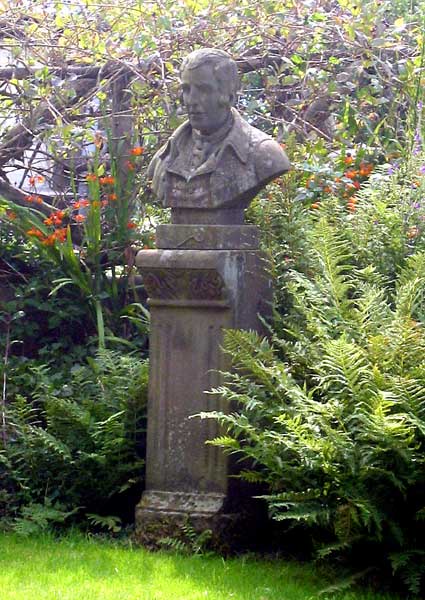Location
Millburn, 8 Arbuthnott Street, Bridgefield, Stonehaven. Private garden no access
Stonehaven, Kincardine
Date
Early 1900s
Description
Sandstone bust of the poet Robert Burns (b. 25 Jan 1759 d. 21st July 1796, at the age of 37) on a columnar pedestal by Robert Taylor 'Ghosty Bob' a local monumental mason and sculptor (his nickname a result of his work carving many gravestones). This was the first statue of Burns that the artist did. Both works ultimately derive from the 1787 portrait by Alexander Nasmyth (1758-1840). This seems to be regarded as the definitive image and has been used as a source for most of the huge number of later representations, it is certainly more flattering than the portrait painted by Peter Taylor in 1786.
This bust is in a much more classical style than his Burns Statue in the Burns Garden at David Street (see related artefact) which was created as a result of a commision resulting from this one, but was never collected.
The characters Souter Johnie and Tam 'o Shanter look down on you as you view the Master, from the garden wall.
Related Information
The principal connection of Burns with the town is William Burnes - the poet's father who was born at Clochnahill (west of the A90 about 3 miles southwest of Stonehaven) in 1721 and became, like his own father, a gardener. He had to leave his native county in search of work and, after a period spent in Edinburgh, arrived in Ayrshire in 1750 eventually becoming a tenant farmer, we also know Burns was in Stonehaven on 10th September 1787, where he met his cousin James Burness.
Era
1900s
Information Source
Local Newspaper cuttings, SCRAN, National portrait gallery http://www.npg.org.uk/, www.robertburns.org etc
Related Artefacts
Categories
Iconography
- human face or head
- plant
Creator
- Robert Taylor 'Ghosty Bob', Sculptor
External Links
Photographer
- Martin Sim
Unavailable Data
- OS Map Reference
This content was submitted by external contributors and does not necessarily reflect the views of the University of Aberdeen.

